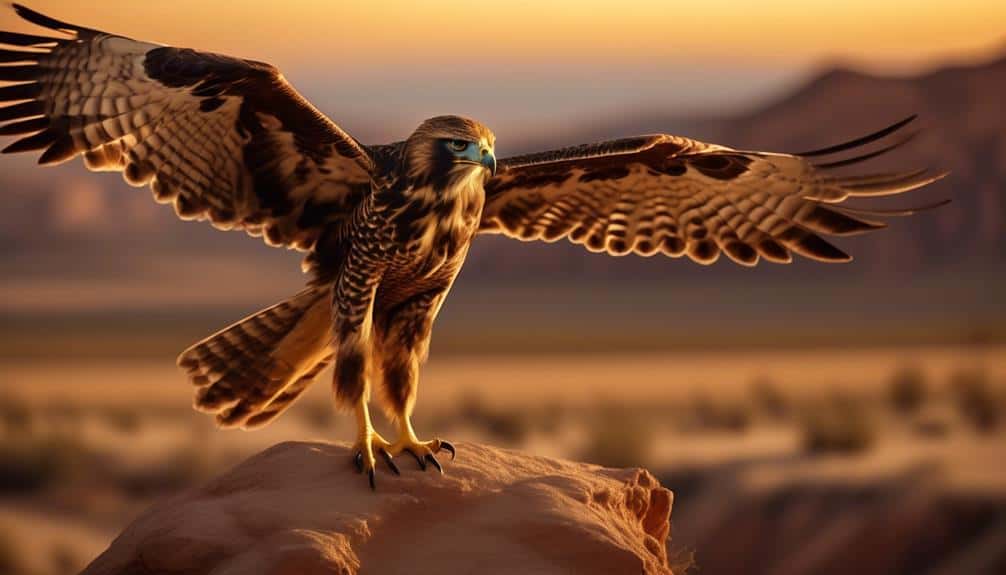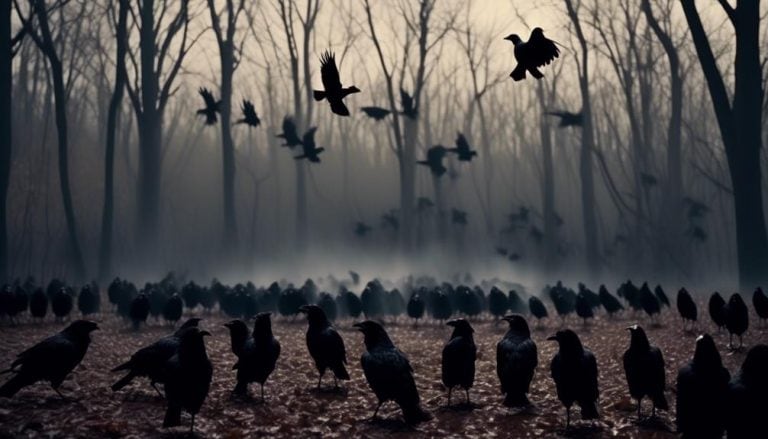As a nature enthusiast, I find myself captivated by the captivating creatures that soar through the skies of New Mexico: the Birds of Prey. From the majestic Bald Eagle to the elusive Ferruginous Hawk, these formidable predators possess a grace and power that is truly awe-inspiring.
But there is one bird that reigns supreme in the world of avian speed and agility, a bird that can leave even the most seasoned birdwatcher in awe. Curious to know more? Well, let me tell you about the fastest bird in the world, a true marvel of nature: the Peregrine Falcon.
The Bald Eagle: A Majestic Symbol of New Mexico
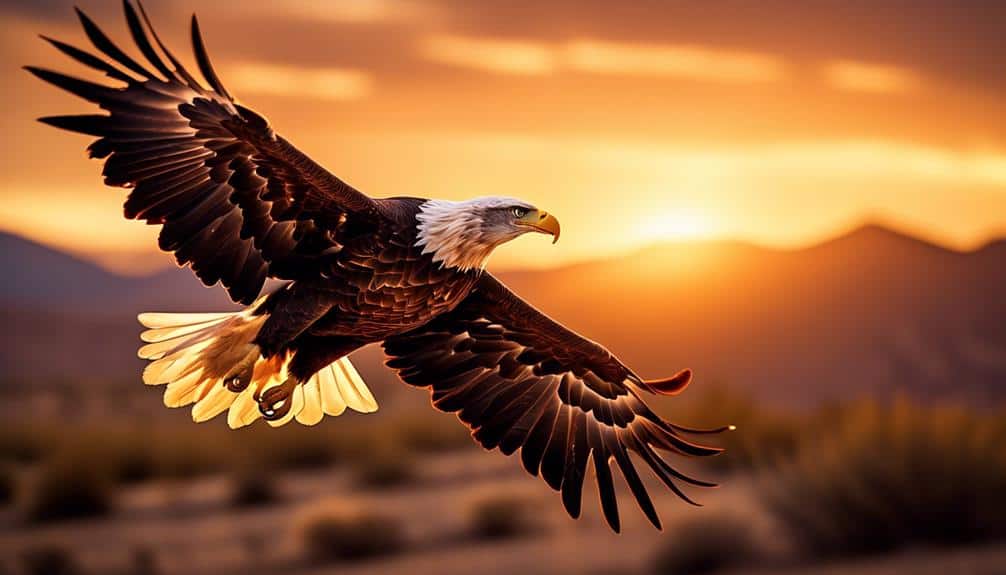
The Bald Eagle, a powerful raptor with a wingspan reaching up to 7 feet, is revered as a majestic symbol of New Mexico. The history of bald eagle conservation efforts in the state is a testament to their cultural significance.
In the early 20th century, these magnificent birds faced a severe decline in population due to habitat loss, hunting, and the use of pesticides like DDT. Recognizing their importance, conservation efforts were initiated to protect and restore their habitats. Through the efforts of federal agencies, such as the U.S. Fish and Wildlife Service, and collaborations with local organizations, the bald eagle population in New Mexico has seen a remarkable recovery. Today, the state is home to several nesting pairs and is considered a vital habitat for these birds.
The cultural significance of bald eagles in New Mexico can't be understated. They're seen as symbols of strength, freedom, and resilience. They hold a special place in the hearts of the people, representing the natural beauty and diversity of the state. The sight of a bald eagle soaring through the sky is a source of inspiration and awe for both residents and visitors alike.
The Ferruginous Hawk: The Elusive Hunter of the Southwest
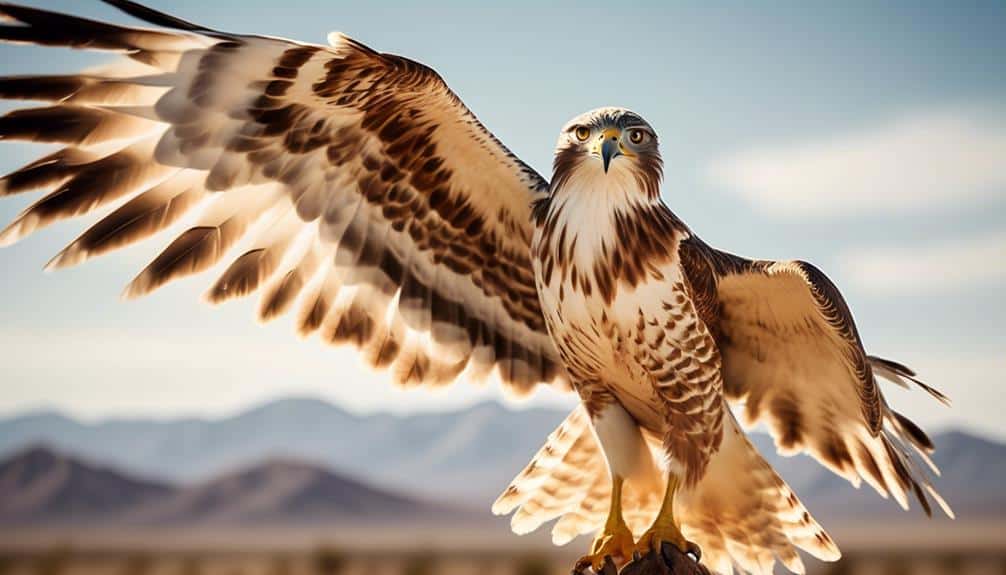
After exploring the cultural significance of the bald eagle in New Mexico, it's time to shift our focus to another fascinating bird of prey found in the region: the Ferruginous Hawk. This majestic raptor is known for its elusive hunting techniques and unique habitat preferences.
Elusive hunting techniques:
- The Ferruginous Hawk employs a strategy known as 'still-hunting,' where it perches motionless for extended periods, scanning the ground for prey.
- Once a suitable target is spotted, the hawk swoops down with incredible speed and precision to capture its prey.
- It's also known to engage in aerial hunting, soaring high above the ground and diving down to snatch unsuspecting prey.
Unique habitat preferences:
- The Ferruginous Hawk prefers open grasslands and prairies, often found in the southwestern United States, including New Mexico.
- It requires large territories for hunting and nesting, typically avoiding areas with dense vegetation.
- This bird of prey is well-adapted to arid environments, as it can survive on a diet of small mammals, reptiles, and birds found in these habitats.
The Ferruginous Hawk's elusive hunting techniques and unique habitat preferences make it a truly remarkable species to observe in the Southwest. Its ability to adapt to challenging environments showcases the resilience and resourcefulness of these magnificent birds of prey.
The Great Horned Owl: Silent Predator of the Night

As a silent predator of the night, the Great Horned Owl possesses remarkable adaptations that enable it to navigate and hunt in the darkness. One of the most notable features of the Great Horned Owl is its large, forward-facing eyes. These eyes are perfectly adapted for low light conditions, allowing the owl to see clearly even in near darkness. Additionally, the owl's eyes are fixed in their sockets, so it must rotate its entire head to change its field of vision.
When it comes to hunting, the Great Horned Owl is a master of stealth. Its feathers are specially designed to minimize sound, allowing it to fly silently through the night sky. This stealthy flight, combined with its excellent hearing, makes the owl a formidable predator. In fact, the owl's hearing is so acute that it can locate prey solely by sound. Its facial disc, a ring of feathers around its face, acts as a sound collector, funneling sound to its ears and allowing it to pinpoint the exact location of its prey.
Once the Great Horned Owl has located its prey, it swoops down with incredible speed and precision. It uses its sharp talons to grasp its prey, and its powerful beak to deliver a swift and lethal bite. The owl's hunting techniques are well-suited for capturing a wide range of prey, including small mammals, birds, and even reptiles.
The Peregrine Falcon: The Fastest Bird in the World
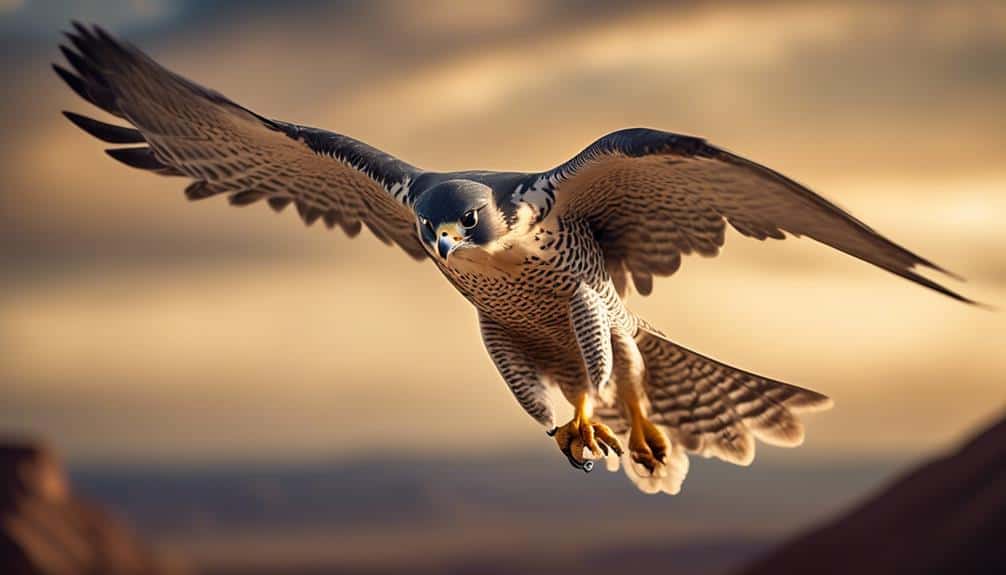
Having explored the remarkable adaptations of the Great Horned Owl, it's now time to shift our focus to the Peregrine Falcon, a bird renowned for its incredible speed and agility.
The Peregrine Falcon (Falco peregrinus) is widely recognized as the fastest bird in the world, capable of reaching speeds up to 240 miles per hour (386 kilometers per hour) during its hunting dives, known as stoops. This astonishing speed is attributed to several factors, including its streamlined body shape, powerful flight muscles, and specialized respiratory system.
The hunting techniques of the Peregrine Falcon are equally impressive. It primarily preys on other birds, using a combination of speed, precision, and strategy. Here are three notable hunting techniques employed by the Peregrine Falcon:
- High-speed stoop: When hunting, the falcon climbs to great heights before plummeting towards its prey in a steep, rapid descent. This stoop allows the falcon to deliver a swift and deadly blow to its target.
- Aerial acrobatics: During pursuit, the Peregrine Falcon employs remarkable aerial maneuvers, such as mid-air twists and turns, to outmaneuver its prey. This agility enables it to maintain a visual lock on its target and strike with precision.
- Ambush hunting: In addition to its high-speed stoop, the Peregrine Falcon also utilizes ambush tactics. It often perches on high vantage points, such as cliffs or tall buildings, and surprises its prey from above, catching them off guard.
Despite its impressive hunting abilities, the Peregrine Falcon has faced significant threats to its population. Due to pesticide use, habitat loss, and illegal hunting, the Peregrine Falcon was once critically endangered. However, conservation efforts, including captive breeding and habitat protection, have led to a remarkable recovery. Today, the Peregrine Falcon's conservation status is listed as 'least concern' by the International Union for Conservation of Nature (IUCN).
Continued conservation efforts are crucial to ensure the survival of this iconic and awe-inspiring bird.
The Cooper's Hawk: A Stealthy Hunter in Urban Environments
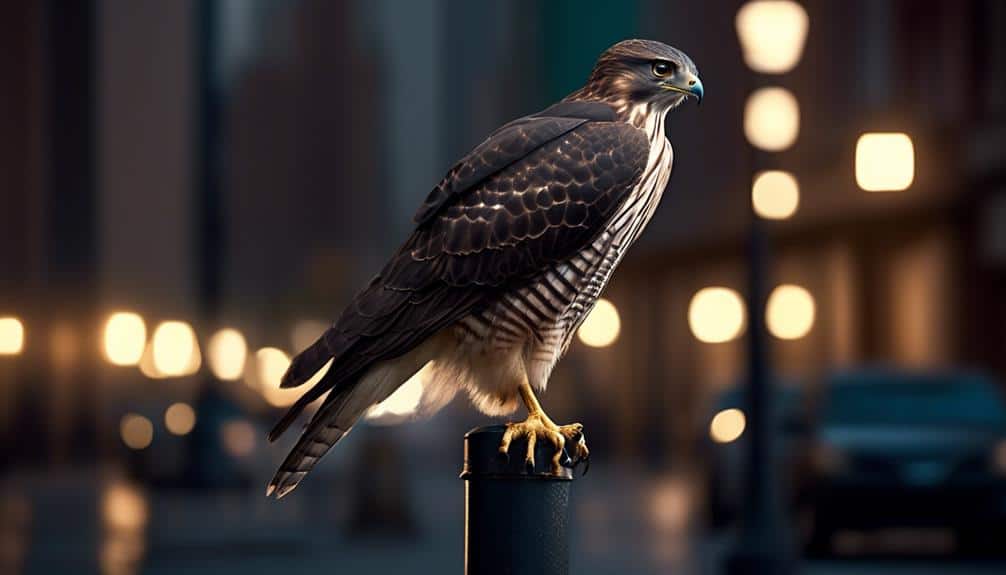
The Cooper's Hawk (Accipiter cooperii) is a stealthy predator that excels in hunting within urban environments. This species has adapted remarkably well to the challenges of urban life, taking advantage of the abundance of prey and the many structures that provide cover for their hunting activities.
One of the key factors contributing to their success in urban environments is their remarkable urban camouflage. With their bluish-gray plumage on their back and wings, barred reddish-brown breast, and dark eyes, Cooper's Hawks blend seamlessly into the urban landscape, making it easier for them to approach their prey unnoticed.
In terms of hunting techniques, Cooper's Hawks are renowned for their agility and speed. They're masterful fliers, capable of maneuvering through tight spaces and navigating complex urban environments with ease. Their long tails and rounded wings allow for quick turns and precise flight control, enabling them to chase their prey with great accuracy.
They employ a strategy known as 'still-hunting,' where they perch in a concealed location, patiently waiting for an opportunity to strike. Once they spot their target, they swiftly launch into action, using their powerful talons to capture their prey mid-flight.
Frequently Asked Questions
What Is the Average Wingspan of the Bald Eagle?
The average wingspan of the bald eagle is around 6 to 7 feet. This majestic bird is known for its impressive size and strength, making it a symbol of power and freedom.
How Does the Ferruginous Hawk Hunt and Capture Its Prey?
The ferruginous hawk, with its impressive wingspan, utilizes various hunting techniques to capture its prey. With keen eyesight and agile flight, it employs strategies such as soaring, hovering, and stooping to target and seize its unsuspecting victims.
What Are the Adaptations That Allow the Great Horned Owl to Be a Successful Nocturnal Predator?
The great horned owl employs a variety of nocturnal hunting strategies to be a successful predator. Its adaptations include keen hearing, silent flight, and specialized feathers for camouflage, allowing it to locate and capture prey in the darkness.
How Fast Can the Peregrine Falcon Fly and What Enables It to Achieve Such High Speeds?
The peregrine falcon, known for its incredible speed, can reach speeds of up to 240 miles per hour during its hunting dives. This impressive feat is achieved through its streamlined body and specialized wing shape, which optimize its aerodynamics for high-speed flight.
How Does the Cooper's Hawk Adapt to Hunting in Urban Environments?
The Cooper's hawk, known for its adaptability, employs various urban hunting techniques. It utilizes its exceptional agility, keen eyesight, and ability to fly swiftly through dense vegetation to capture prey in urban environments.
Conclusion
In conclusion, the birds of prey in New Mexico exhibit remarkable abilities and play crucial roles in maintaining the ecosystem's balance.
From the majestic Bald Eagle to the elusive Ferruginous Hawk, these predators demonstrate exceptional hunting skills and adaptability to their environments.
As I reflect on their intricate nature, I can't help but wonder: How do these magnificent creatures navigate the vast landscapes of New Mexico with such precision and grace?

